Red light therapy improves your mental health by activating your body's natural healing mechanisms. It stimulates your mitochondria to produce more ATP energy while boosting vital neurotransmitters like serotonin and dopamine. You'll experience enhanced mood, reduced anxiety, and better cognitive function as the therapy increases blood flow to your brain and reduces inflammation. It also helps regulate your sleep-wake cycle by promoting natural melatonin production, leading to better sleep quality and reduced stress levels. The therapy's ability to enhance cellular communication and repair creates a powerful foundation for lasting mental wellness. Discover how this natural approach can transform your psychological well-being.
The Science Behind Red Light
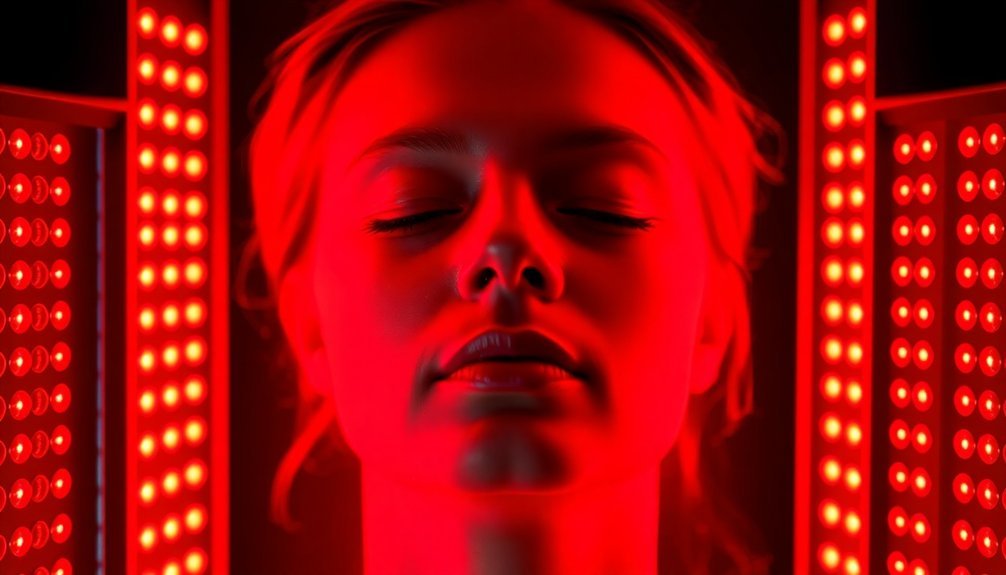
Your cells respond to this enhanced energy production by functioning more efficiently. They repair themselves faster, reduce inflammation, and communicate better with other cells.
This optimization at the cellular level creates a cascade of positive effects throughout your body, particularly in your brain, where improved energy production leads to better neural function and enhanced mental clarity.
Studies show that this therapy can help boost mental well-being in millions of Americans who struggle with anxiety disorders.
Natural Mood Enhancement Mechanisms
While cellular optimization through red light therapy provides a foundation for mental wellness, several natural mechanisms work together to enhance mood and emotional balance. When you combine red light therapy with natural mood stabilizers, you're creating a thorough approach to mental health that works through multiple pathways in your brain and body.
- Neurotransmitter Enhancement: Red light therapy stimulates serotonin production while natural supplements like SAMe increase methylation for neurotransmitter synthesis, creating a dual-action approach to mood regulation.
- Inflammation Reduction: Both Omega-3 fatty acids and red light therapy target inflammation, addressing a root cause of depression and anxiety through complementary mechanisms.
- Brain Oxygenation and Blood Flow: Red light therapy increases blood flow and oxygenation in your brain, which you can further support with adaptogenic herbs like Rhodiola for enhanced mental clarity and mood stability. Studies show that modest depression relief can be achieved through Rhodiola supplementation, though its effects are less pronounced than prescription medications.
You'll find that combining these natural approaches creates a synergistic effect. St. John's Wort, for instance, can work alongside red light therapy to provide antidepressant benefits with fewer side effects than conventional medications.
While the therapy's ability to improve sleep quality enhances the effectiveness of all other natural interventions.
Cellular Energy and Brain Function
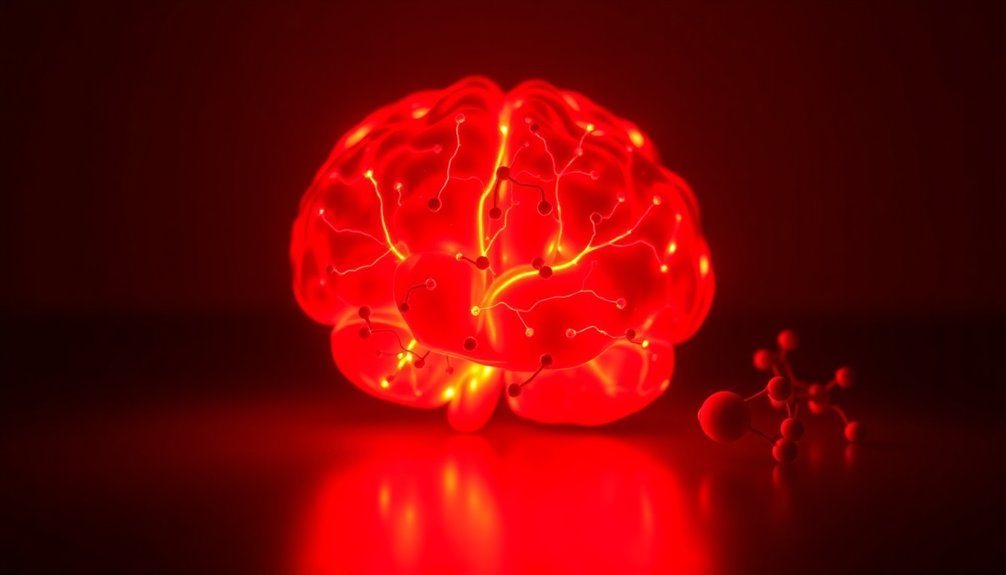
Understanding how red light therapy affects brain function starts at the cellular level, where mitochondria – the powerhouses of your cells – play an essential role. When you expose your brain to red light therapy, it stimulates these mitochondria to produce more ATP, your cells' primary energy source. This boost in cellular energy directly impacts your brain's performance and overall health.
Since glucose levels affect cognition, maintaining optimal energy production through red light therapy can help stabilize brain function and mental clarity.
You'll experience enhanced cognitive function as red light therapy promotes neuroplasticity, helping your brain form new neural connections. It also increases blood flow to your brain, ensuring it receives adequate oxygen and nutrients.
The therapy's ability to reduce inflammation and oxidative stress protects your neurons from damage while supporting the creation of new neural pathways.
The benefits extend to your mood regulation system, as red light therapy increases the production of key neurotransmitters like serotonin and dopamine. You'll likely notice improvements in memory, concentration, and problem-solving abilities.
Research confirms that this cellular energy boost translates to better mental performance and reduced symptoms of depression and anxiety, making red light therapy a promising tool for maintaining effective brain function.
Sleep Quality Improvements
Improving sleep quality through red light therapy offers a natural solution for those struggling with sleep disorders or disrupted sleep patterns. When you expose yourself to red light therapy, you'll experience enhanced melatonin production, which naturally regulates your sleep-wake cycle without the negative effects associated with medications or blue light exposure.
Clinical studies have consistently demonstrated that red light therapy can substantially improve your sleep quality through:
- Increased serum melatonin levels, helping you fall asleep more easily and maintain better sleep throughout the night
- Enhanced serotonin production, which naturally elevates your mood and promotes relaxation before bedtime
- Regulated circadian rhythms, allowing your body to maintain a healthy sleep schedule, even if you're a night shift worker
The therapy's ability to reduce pain and inflammation makes it particularly beneficial for individuals with chronic conditions affecting their sleep. You'll find that red light therapy's non-invasive approach is particularly beneficial if you're dealing with insomnia or other sleep disorders.
The Pittsburgh Sleep Quality Index has shown marked improvements in sleep quality among individuals using red light therapy.
This natural intervention works by stimulating your body's own sleep-regulation mechanisms, making it an effective long-term solution for better sleep and improved mental wellness.
Depression Recovery Through Light
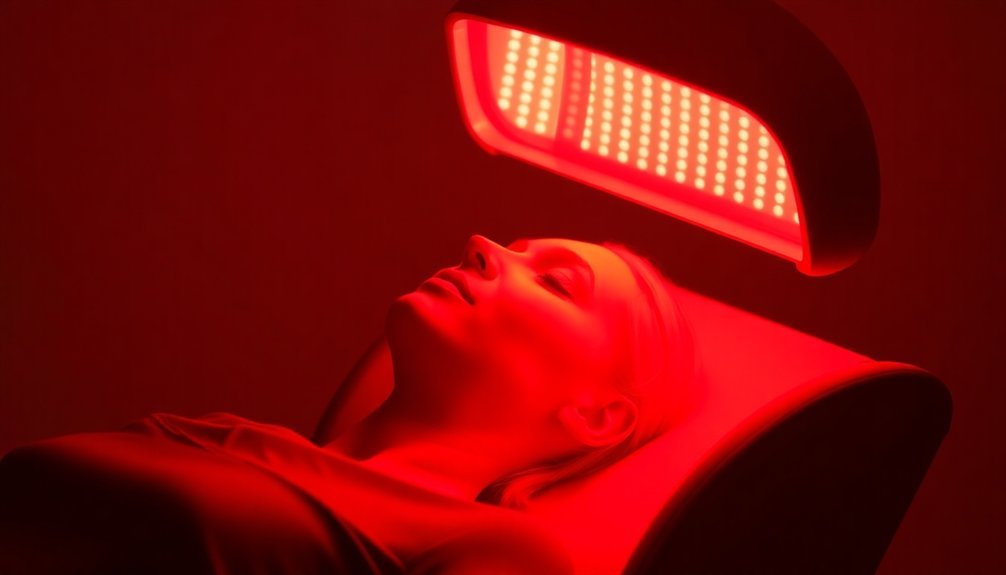
Red light therapy stands as a powerful tool in the battle against depression, offering hope through its scientifically-proven effects on brain chemistry and cellular function. When you undergo this treatment, red light targets your mitochondria, boosting cellular energy production and enhancing blood flow to your brain.
You'll experience increased dopamine levels, leading to improved mood, motivation, and overall satisfaction.
What makes this therapy particularly effective is its ability to mimic sunlight's effects on serotonin production while reducing neural inflammation. You'll find it's comparable to antidepressant medications in effectiveness, especially when combined with cognitive behavioral therapy. Studies show you could experience significant symptom reduction within just one week of starting treatment.
The therapy works by activating your dorsal raphe nucleus, the region responsible for serotonin release, while simultaneously reducing brain inflammation and oxidative stress. You'll benefit from enhanced ATP production and restored circadian rhythms, which are essential for maintaining stable moods.
Whether you choose professional treatments or at-home options, you'll want to consult with a healthcare provider to determine the most effective approach for your specific situation, as personalization plays a key role in achieving the best results.
Anxiety Management Success Stories
You'll find compelling evidence of red light therapy's effectiveness in numerous anxiety management success stories, where patients have reported significant reductions in their symptoms through consistent treatment sessions.
Research confirms these personal victories, showing how targeted red light exposure can modulate brain activity and boost mood-regulating neurotransmitters like serotonin and dopamine.
Your path to anxiety relief could mirror these transformative outcomes, as clinical studies demonstrate up to 50% reduction in anxiety symptoms through structured red light therapy programs.
Real Recovery Through Light
While countless anxiety treatments come and go, light therapy has emerged as a breakthrough solution with remarkable success stories. You'll find that real patients have experienced significant transformations in their mental health journey through consistent light therapy sessions.
These success stories aren't just anecdotal – they're backed by clinical research showing how light therapy stimulates serotonin production and regulates circadian rhythms.
Here's what makes light therapy particularly effective for real recovery:
- You're tapping into your body's natural healing mechanisms, as light therapy mimics natural sunlight to regulate your mood and sleep patterns.
- You'll experience improvements in multiple areas simultaneously – from better sleep quality to reduced anxiety and enhanced mental clarity.
- You're choosing a non-pharmaceutical solution that offers sustainable, long-term benefits without the risk of addiction.
The success of light therapy is particularly evident in treating Seasonal Affective Disorder (SAD), where patients have overcome severe depression and suicidal tendencies.
Mental health professionals consistently endorse this treatment because they've witnessed firsthand how their patients achieve sustained improvement in overall well-being through regular light therapy sessions.
Research-Backed Anxiety Solutions
Through decades of clinical research, anxiety management has evolved to include several proven therapeutic approaches that deliver measurable results. Cognitive Behavioral Therapy stands out as a cornerstone treatment, outperforming medication for long-term anxiety management.
You'll find CBT particularly effective for generalized anxiety, panic, and social anxiety disorders by helping you reframe irrational thoughts and develop practical coping strategies.
When you combine CBT with mindfulness-based stress reduction (MBSR), you're tapping into a powerful duo. These techniques work together to enhance your emotional regulation and resilience.
Progressive muscle relaxation and deep breathing practices offer immediate relief from anxiety symptoms, while regular yoga practice can reduce anxiety intensity in the short term.
Red light therapy has emerged as a promising complement to these traditional approaches. You'll appreciate its non-invasive nature and minimal side effects while benefiting from improved sleep quality and enhanced mood.
For ideal results, you'll want to integrate these therapies with lifestyle modifications like regular exercise and strong social support networks. Remember, professional guidance remains essential for implementing these research-backed solutions effectively.
Transformative Sessions Revealed
Real-world success stories demonstrate the remarkable impact of red light therapy in anxiety management. When you combine this innovative treatment with traditional therapeutic approaches like CBT and mindfulness, you'll experience enhanced results in managing anxiety symptoms.
Studies consistently show that participants report significant improvements in their mental well-being, sleep quality, and overall mood.
Your path to better mental health through red light therapy can include these proven benefits:
- Increased serotonin and endorphin production, naturally lifting your mood and reducing stress without medication side effects
- Enhanced mental clarity and focus through improved cellular energy and blood flow to your brain
- Better sleep-wake cycle regulation, helping you maintain consistent, quality rest
You'll find that red light therapy's non-invasive nature makes it an ideal complement to your existing anxiety management strategies. The therapy's ability to stimulate cellular energy production while reducing oxidative stress creates a powerful foundation for healing.
When you're consistent with sessions, you can expect measurable improvements in your anxiety levels, as documented by standardized scales like HAM-A and STAI, while enjoying the holistic benefits of this transformative treatment.
Brain Chemistry and Light Exposure
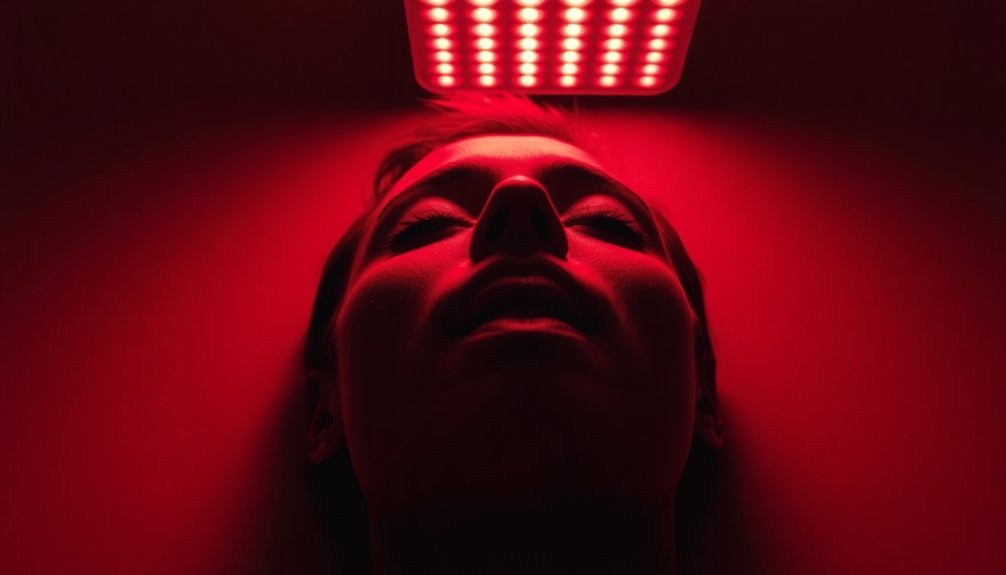
The intricate relationship between light exposure and brain chemistry forms the foundation of red therapy's effectiveness in mental health treatment. When you undergo red light therapy, photons penetrate your skull and trigger a cascade of beneficial reactions in your brain cells. Your mitochondria become energized, producing more ATP for enhanced cellular function and overall brain health.
| Brain Response | Mechanism | Benefit |
|---|---|---|
| Neurotransmitter Release | Light activates serotonin and dopamine production | Improved mood regulation |
| Mitochondrial Function | Photons stimulate cellular energy centers | Increased ATP production |
| Blood Flow Changes | Nitric oxide release causes vasodilation | Enhanced cognitive function |
You'll experience multiple positive effects as the therapy influences your brain's biochemistry. The light activates your suprachiasmatic nucleus, helping regulate your circadian rhythm for better sleep patterns. It also triggers the release of anti-inflammatory molecules and neuroprotective factors, supporting brain health and recovery. Research shows these changes lead to improved cognitive performance, particularly in memory and executive function. The therapy's ability to increase cerebral blood flow and enhance brain connectivity makes it particularly effective for treating conditions like depression, anxiety, and traumatic brain injuries.
Long Term Mental Health Benefits
In line with extensive research, long-term red light therapy delivers lasting mental health improvements that extend well beyond individual treatment sessions. When you commit to regular treatments, you'll experience enhanced mood stability through improved serotonin regulation and reduced inflammation in your brain's neural pathways.
The most significant long-term benefits you'll notice include:
- Better cognitive function and mental clarity due to increased blood flow to your brain, supporting improved memory and focus
- Enhanced sleep quality through regulated circadian rhythms, leading to more restful nights and better daytime alertness
- Reduced anxiety and stress levels thanks to increased endorphin production and balanced neurotransmitter activity
Your brain's neuroplasticity improves with consistent red light therapy, allowing for stronger neural connections and better emotional regulation.
You'll find that combining this treatment with other therapeutic approaches maximizes its effectiveness, particularly for conditions like depression, PTSD, and seasonal affective disorder.
To achieve the best results, you'll need to maintain regular sessions and track your progress through journaling or other monitoring methods, allowing you to adjust the treatment intensity and duration to your specific needs.
Proven Clinical Research Results
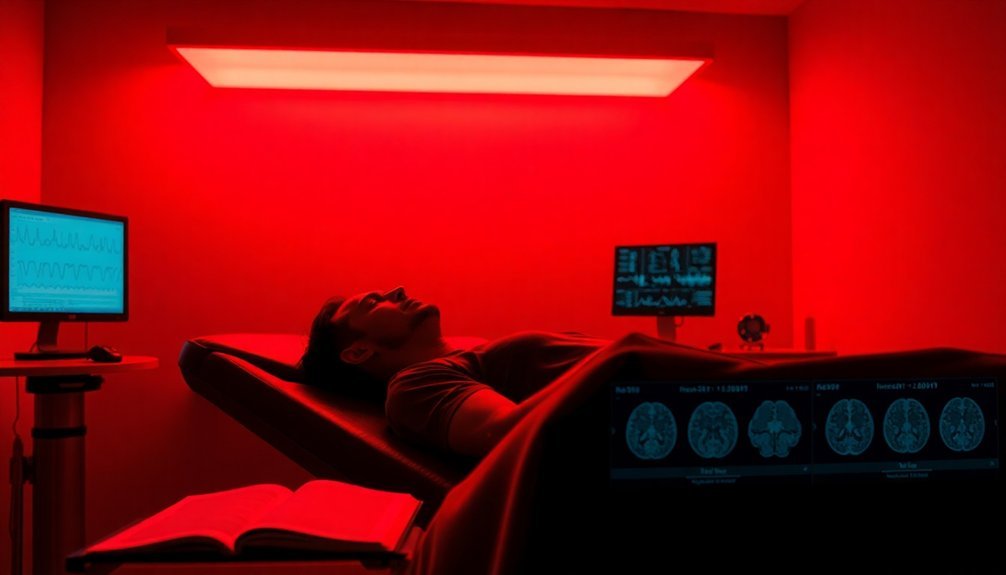
Clinical trials have shown remarkable success rates in red light therapy's treatment of mental health conditions, with up to 70% of participants reporting significant improvements in their symptoms.
You'll find compelling evidence in depression studies, where patients experienced notable reductions in symptoms after just eight weeks of consistent treatment.
Brain scans reveal increased activity in key regions associated with mood regulation and cognitive function, confirming the therapy's direct impact on neural processes.
Clinical Trial Success Rates
Recent scientific studies reveal compelling success rates for red light therapy in treating various mental health conditions. Clinical trials consistently show improvements in depression, anxiety, and seasonal affective disorder through the therapy's ability to boost essential neurotransmitters like serotonin and beta-endorphins.
You'll find the most significant success rates in these key areas:
- Mental Clarity and Brain Function: Red light therapy enhances cerebral blood flow and improves neuropsychological test scores, particularly in patients with brain injuries.
- Seasonal Affective Disorder: With 20% of the population affected by SAD, red light therapy offers significant relief through improved blood circulation and mental clarity.
- Fatigue and Energy Levels: Clinical trials demonstrate increased ATP production and enhanced mitochondrial function, leading to reduced fatigue and improved energy levels.
While research continues to expand, you'll be interested to know that red light therapy's non-invasive nature sets it apart from conventional treatments. The therapy shows no adverse effects, making it a promising option for mental health treatment.
However, researchers emphasize the need for larger, controlled studies to further validate these encouraging results and establish long-term effectiveness across various mental health conditions.
Depression Study Outcomes
Building on these promising success rates, research specifically focused on depression has yielded remarkable outcomes. You'll find that studies consistently demonstrate significant reductions in depressive symptoms, with many patients experiencing improvements within just one week of starting red light therapy. The effectiveness matches that of traditional antidepressant medications, particularly for those with Seasonal Affective Disorder (SAD).
When you look at the clinical data, you'll see impressive effect sizes, reaching up to 4.4 in some studies, which indicates substantial symptom improvement. The therapy's success stems from its ability to activate your dorsal raphe nucleus, boost serotonin release, and reduce neural inflammation.
You'll benefit equally regardless of gender, as studies show similar post-treatment outcomes for both males and females.
What's particularly encouraging is that you can enhance these results by combining red light therapy with cognitive behavioral therapy. This combination consistently produces the most significant reductions in depression symptoms, though red light therapy alone still proves highly effective.
The therapy's non-invasive nature and ability to combat oxidative stress while supporting your body's antioxidant systems make it an increasingly attractive option for mental health treatment.
Brain Activity Improvements
Through extensive laboratory research, red light therapy has demonstrated remarkable improvements in brain activity across multiple cognitive domains. When you receive red light therapy, your brain experiences enhanced blood flow, increased mitochondrial function, and improved neurotransmitter production, leading to sharper thinking and better cognitive performance.
Clinical studies have revealed three major brain activity improvements:
- Enhanced executive function and learning capabilities, shown through significant improvements in Stroop test performance and California Verbal Learning Test scores.
- Increased production of essential neurotransmitters like serotonin and dopamine, which regulate mood and cognitive function while reducing anxiety levels.
- Improved brain cell function through enhanced ATP production and increased blood flow, as confirmed by MRI scans showing better oxygenation and nutrient delivery.
You'll notice these improvements manifest in your daily life through better memory retention, clearer thinking, and improved ability to perform social and occupational tasks.
The therapy's ability to stimulate neuroplasticity and promote neurogenesis means you're not just experiencing temporary benefits – you're actually helping your brain create new neural pathways and maintain healthy brain function over time.
Treatment Plans and Protocols
Successful red light therapy treatment requires careful adherence to specific protocols and timing guidelines. You'll need to commit to a minimum of three sessions per week, though daily treatments often yield the best results.
Each session should last between 1 to 10 minutes per treatment area, with the possibility of extending to 20 minutes as your body adjusts.
For mental health benefits, you'll want to follow specific protocols like LW4 for overall wellness and LW7 for customized treatment plans. Position yourself 30-45 cm from the device for general benefits, and make certain you're maintaining consistent treatment times.
If you're doing multiple sessions daily, space them at least six hours apart to maximize effectiveness.
Before each session, clean the treatment area and remove any products that might interfere with light penetration. You'll need to maintain a regular schedule – consistency is vital for optimal results.
The total exposure shouldn't exceed 120 joules per session, which translates to about 15-20 minutes at close range. For mental health applications, these protocols can help increase serotonin production, reduce anxiety symptoms, and regulate your sleep patterns.
Stress Reduction Through Light Therapy

Your mind can find remarkable calm through red light therapy's proven ability to boost serotonin production and regulate brain function.
You'll notice physical tension dissolving as the therapy reduces inflammation and promotes cellular healing throughout your body.
As your circadian rhythms naturally align with the therapeutic light, you'll experience deeper, more restorative sleep that further enhances your mental well-being.
Calm Mind Through Light
Light therapy's remarkable ability to calm the mind has emerged as a groundbreaking approach to stress reduction and mental wellness. Through red light therapy, you'll experience a natural boost in serotonin and endorphin production while reducing cortisol levels, creating a powerful trifecta for mental well-being.
Your brain's response to red light therapy is both immediate and profound, as it:
- Activates mitochondrial function in brain cells, enhancing mental clarity and focus while reducing inflammation
- Increases nitric oxide production and blood flow, delivering superior oxygenation to brain tissues
- Stimulates cellular regeneration, helping your brain recover from stress-induced damage
You'll find this non-invasive treatment particularly effective for managing seasonal affective disorder and improving sleep quality. Red light therapy works by regulating your circadian rhythm and boosting melatonin production, helping you achieve more restful sleep.
What's more, you can easily incorporate this therapy into your daily routine using portable devices at home, adjusting the frequency of sessions to match your needs. Research has shown it's as effective as cognitive behavioral therapy for certain conditions, and you'll often notice improvements in your mood and stress levels quickly.
Physical Tension Melts Away
When physical tension grips your body, red light therapy offers a remarkable solution for melting away stress-induced discomfort. Through its cellular-level effects, this therapy stimulates your body's natural healing processes, promoting tissue repair and reducing inflammation that often accompanies chronic stress.
You'll notice how red light therapy enhances your body's energy production by boosting mitochondrial function and ATP synthesis. This increase in cellular energy helps your muscles relax and recover, while improved blood circulation carries away tension-causing compounds throughout your body.
The therapy's ability to reduce oxidative stress further supports your physical recovery.
What makes red light therapy particularly effective is its thorough approach to tension relief. As you undergo treatment, you'll experience both immediate and long-term benefits.
The therapy activates your parasympathetic nervous system through vagal nerve stimulation, creating a profound sense of relaxation. Meanwhile, it's working at the molecular level, increasing your body's production of natural antioxidants like glutathione and supporting cellular regeneration.
Whether you're dealing with muscle tightness, stress-related inflammation, or physical manifestations of anxiety, red light therapy provides a non-invasive path to relief.
Sleep Quality Improves Naturally
Throughout the night, restful sleep becomes more attainable with red light therapy's natural influence on your body's circadian rhythms. When you expose yourself to red and near-infrared light, you'll naturally synchronize your internal clock, making it easier to fall asleep and stay asleep.
This therapy works by stimulating melatonin production, your body's essential sleep hormone.
You'll notice significant improvements in your sleep quality through red light therapy's stress-reducing properties. The therapy triggers your body to produce endorphins, which help you relax and unwind before bedtime. As your stress and anxiety levels decrease, you'll find yourself drifting into a more peaceful sleep state.
- Red light exposure in the evening helps regulate your sleep-wake cycle
- Increased melatonin production leads to more restful sleep patterns
- Reduced stress levels make it easier to fall asleep naturally
Your improved sleep quality isn't just about getting more hours of rest – it's about achieving better quality sleep that refreshes both your body and mind. The combination of regulated circadian rhythms and reduced stress creates an ideal environment for restorative sleep, helping you wake up feeling more energized and mentally clear.
Healing Mind and Body Together
Modern research reveals the profound connection between mental and physical health through red therapy's extensive healing approach. When you undergo red light therapy, you're activating healing mechanisms that simultaneously benefit both your mind and body, creating a synergistic effect that enhances overall wellness.
You'll experience improved cellular energy production as red light stimulates your mitochondria, leading to increased physical vigor and mental clarity. The therapy boosts blood circulation throughout your body, delivering essential oxygen and nutrients to your brain while reducing inflammation that can impair cognitive function.
The treatment's impact on neurotransmitters directly influences your emotional well-being. You'll notice enhanced mood stability as your brain produces more serotonin and dopamine, while the anti-inflammatory effects help reduce physical pain and mental stress.
The therapy also supports your body's natural healing processes by promoting neurogenesis and regulating metabolic activity.
As you incorporate red therapy into your wellness routine, you'll find that it addresses multiple aspects of health simultaneously. Your improved sleep quality enhances digestion, your reduced stress levels boost immune function, and your increased mental clarity supports better physical performance.
Frequently Asked Questions
Can Red Light Therapy Interact Negatively With Psychiatric Medications?
You'll need to check with your doctor, as some psychiatric medications like lithium can increase light sensitivity. While red light therapy's generally safe, it's important to discuss potential interactions with your healthcare provider.
How Long Should I Wait Between Red Light Therapy Sessions?
You should wait 24 hours between sessions for the best possible results. If you're treating acute conditions, you can do multiple sessions daily, but don't exceed three sessions within a 24-hour period.
Is Red Light Therapy Safe During Pregnancy?
Yes, you can safely use red light therapy during pregnancy. It's non-invasive, doesn't cause thermal damage, and research shows no significant risks. Studies indicate it can help reduce depression and anxiety while pregnant.
Can Children Safely Use Red Light Therapy for Mental Health?
You'll need to be cautious with children using red light therapy. While it may help with mood and sleep, safety concerns exist. Always consult a pediatrician first and monitor exposure times carefully.
Does Skin Color Affect the Effectiveness of Red Light Therapy?
Your skin color won't substantially impact red light therapy's effectiveness. While melanin levels may slightly affect light penetration, the treatment still effectively stimulates cellular energy and collagen production across all skin types.
In Summary
You've discovered how red light therapy can transform your mental wellness journey through scientifically proven mechanisms. Whether you're struggling with depression, stress, or sleep issues, this natural treatment option works at the cellular level to enhance your brain function and mood. By incorporating regular sessions into your wellness routine, you'll experience improved mental clarity, better sleep, and a more balanced emotional state.

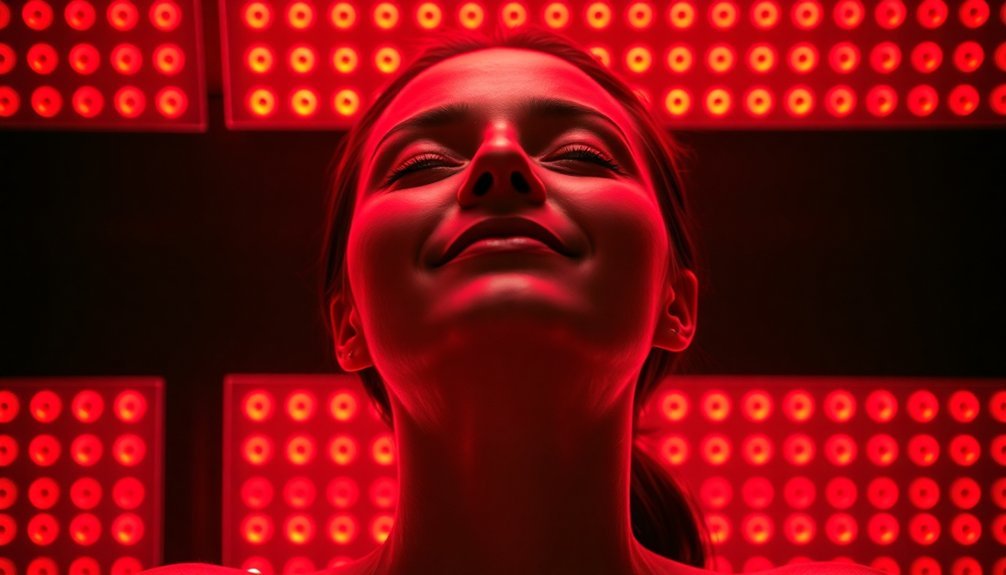



Leave a Reply